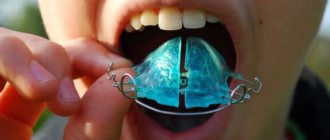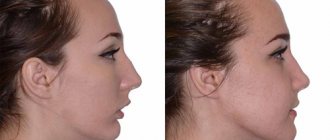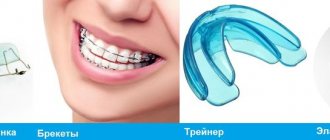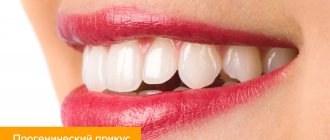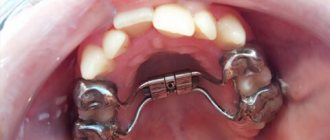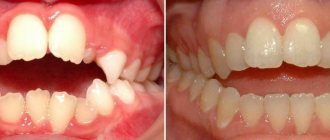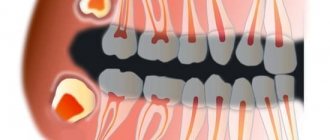What are dental trainers?
Dental trainers are a double-jaw orthodontic device that tightly secures the upper and lower dentition, gradually correcting the incorrect position of the teeth, training the facial muscles and fixing the tongue in the correct position. The design has several components:
- outer part with lip bumpers;
- labial protrusion in the form of an arc;
- part in the oral cavity (tongue stop);
- “tongue”, which is located on the front part from the inside.
Features of the dental structure - trainer
The main function of trainers is to correct the bite.
They are made of silicone material and look like a boxing mouth guard. The process of removing and installing the trainer does not cause discomfort; for these procedures there is no need to visit the dentist's office. The work of trainers is to change the activity of chewing mechanisms. They help not only to change the bite, but also to eliminate the cause of the incorrect position of the teeth. Many specialists can offer similar designs to improve nasal breathing, normal swallowing function, clear pronunciation of words, etc. This happens thanks to a device that affects the muscles, and they begin to work fully. It is much easier to influence the nature of the bite and the growth of teeth in childhood, which is when doctors recommend the use of trainers. However, adults can also apply this treatment; after a short amount of time, the problem with the aesthetic defect will be solved.
What are dental trainers for?
A trainer for straightening teeth is usually prescribed to children aged 5 - 12 years, during the period of mixed dentition. Timely use of the device will eliminate serious problems in the future, since in adulthood, when the jaw bones are already formed, the bite can only be radically corrected through surgery. However, doctors warn that correcting teeth with trainers will only be useful if you follow the wearing regime. If a small patient is not motivated enough or his parents cannot control the process, the technique will not bring results.
A dental trainer for children is prescribed for the following indications:
- mouth breathing;
- parafunction of the tongue;
- bad sucking habits;
- improper eruption of front teeth;
- narrowing of the dentition;
- various malocclusions;
- pronounced crowding of teeth (the teeth do not have enough space on the gums, and they move each other).
Dental trainers are also used to treat patients over 12 years of age who already have a permanent bite. They are used for the following diagnoses:
- class II anomalies (subclasses 1 and 2, distal displacement of the lower first molar in relation to the upper one);
- crowding of the front teeth;
- deep or open bite.
An important purpose of trainers is to form the correct functioning of the jaw muscles, which is very difficult to achieve with the help of plates or braces. A separate function of silicone teeth trainers is retention after wearing braces. However, in most cases, trainers are prescribed to children.
Types of bites that a trainer can help correct?
An orthodontic trainer is not the only device that corrects malocclusions. Only more expensive and complex devices can cope with difficult complex problems. The trainer is able to overcome the problem of improper nasal breathing or bad habits, as well as correct the following types of bite:
- Mesial
– when the lower jaw is moved slightly forward;
- Crowding
, in which the lower front teeth overlap each other;
- Open
– when the lateral or front teeth do not close together;
- Deep
– if the upper incisors overlap the lower ones;
- Distal
– if the upper jaw protrudes forward;
- Improper swallowing
;
- Speech disorders
.
Trainers for teeth - children and adults
In pediatric and adult orthodontics, various models of trainers are used to straighten teeth, each of which has its own purpose.
Trainers for teeth T4K
For older children, T4K dental trainers, the so-called pre-orthodontic ones, are suitable. Treatment on such trainers takes place in two stages - first, the patient wears a soft initial device (blue), then, upon achieving the goals, it is replaced with a more elastic one (pink or red). T4K dental trainers are suitable for early and late mixed dentition. There are also models of trainers for teeth i-3 and i-2 and their varieties, specially designed for the treatment of class 2 and 3 anomalies.
Teeth Trainer T4A
T4A dental trainers are available as initial and final trainers. Initial (blue) is used on replacement teeth. It has a special recess so that the child understands where to put his tongue. This species is almost imperceptible in the mouth. The period of its use varies from 6 to 8 months. The final pink T4A dental trainer provides a more rigid hold on the dentition. You need to wear it for another 6 to 12 months.
Teeth trainer i-3
The i-3 teeth trainer is used to prevent bite defects during the early change of baby teeth. Its wearing period ranges from 4 to 8 months.
Teeth trainers T4A for adults
Orthodontic trainers for teeth T4A are in many ways similar to T4K for children, they are distinguished by slightly increased height of the sides of the labial arches and longer distal ends. Such devices are also available in two types of hardness - initial and final. Such trainers help in the cosmetic alignment of the front teeth and in minor relapses after orthodontic treatment.
Corrective therapy algorithm
The therapy process is conventionally divided into 2 stages:
- 1 half of the course lasts about six months (the period may vary depending on the severity of the pathology). During this time, the patient uses trainers made of soft polymer. This allows the child to get used to the treatment process and adapt to the physical pressure on the teeth;
- Stage 2 involves wearing more rigid structures. With their help, the correction process is completed and the result is consolidated. Duration – from 1 to 1.5 years, in more complex cases, at the discretion of the doctor.
Note: if the doctor determines a mild form of the dental defect, then the course may be shorter. In this case, devices made of hard polymer are immediately used.
How long and how to wear a dental trainer?
The duration of treatment with trainers will depend on the diagnosis. The minimum is 11 - 12 months. In some cases, after wearing trainers, further orthodontic treatment with braces or Invisalign aligners may be required. However, the period of additional treatment will be shorter than without first wearing dental trainers. How to wear a dental trainer? During treatment, the patient wears the device for at least an hour a day and wears it at night.
How to put on a dental trainer? To install the device, you need to place it with the “marker tongue” up and place it so that the tongue touches this “tongue”, then lightly press it with your teeth. Keep in mind that with the trainer installed in your mouth, you can only breathe through your nose. Before putting on an orthodontic trainer, you must thoroughly brush your teeth and wash the device itself with a cleaning agent.
What are they?
This is an elastic splint made of soft material, thanks to which the design fits almost any jaw. Trainers are used to correct malocclusion and abnormal tooth growth.
It has been proven that malocclusion is formed due to the active influence of the maxillofacial muscles on the dentition.
Trainers help reduce the intensity of this pressure and also help get rid of bad habits in children and adolescents, such as thumb sucking, pencil sucking and other objects.
Photo: orthodontic trainer on teeth
Appearance
There are several types of trainers for different purposes. Some are used for baby teeth, others during treatment with braces, and others simply to prevent the development of dental growth abnormalities.
They differ from each other in color. Multi-colored ones are often produced for children, and transparent ones for adults.
What problems do they solve?
These designs are necessary for the prevention and treatment of anomalies in the location of teeth in a row.
These devices are popular due to their action. They are made to eliminate not the symptoms of anomalies in the location of the jaw or teeth, but the reasons why the anomaly developed.
These orthodontic structures allow you to achieve a positive result and consolidate it at the same time . That is, their use minimizes the risk of relapse.
Doctors also prescribe these structures to help a person develop nasal breathing and to accustom the tongue to the correct position.
Trainer care rules
- The orthodontic trainer should be washed with running water after each meal, but it is contraindicated to use boiling water or ice water.
- The device must be cleaned at least twice a day with a brush and paste.
- The orthodontic dental trainer should be stored in a special container.
- The teeth straightening trainer should not be dropped, chewed or moved in the mouth while talking.
If cracks or damage appear on the device, it is necessary to immediately inform the attending orthodontist, since the structure may lose its properties, and bacteria may accumulate in the cracks.
Advantages and disadvantages of the method
Like any orthodontic method, installing trainers is not suitable for everyone; this device has its pros and cons .
- Children's devices are made in color to add emotions to the process of wearing them, while adults can undergo treatment without unnecessary attention to their smile, since the trainers of this line are most often colorless.
- The method does not cause much trouble to use, since the structures are often worn at night, and during the day they can be worn for only an hour and this will be enough for the process of straightening the teeth and easing muscle pressure.
- When using trainers, a person may not feel anything, since they do not create a feeling of discomfort.
- These devices are accessible to many; their price is an order of magnitude lower than the cost of braces or plates.
You can find out the prices for trainers for straightening teeth in adults in the following article.
In a separate publication we will talk about how to correct crooked teeth without braces.
Follow the link https://orto-info.ru/sistemyi-vyiravnivaniya-zubov/lechebno-profilakticheskie-apparatyi/treyner-t4a.html you will find reviews of the T4A trainer for adults.
Types of models
For the T4k orthodontic trainer to work, two stages of treatment are required, during which the aligners are changed.
At the first stage, the baby needs a trainer made in blue. This
construction made of softer material. Due to this, the trainer can easily “adapt” to a specific anomaly (malocclusion or dentition development) and, acting on it, gradually eliminates the problem.
At the second stage of treatment, a more rigid tray of a pink (red) shade is required. It is intended to consolidate the obtained result. Duration of use – from 3 to 6 months.
Before purchasing a t4k trainer, installing it or replacing it with a new one, you need to consult an orthodontist.
And remember that the treatment must be consistent or continuous, otherwise all the work after a few weeks will be in vain and you will have to start over.
Why is it important to correct your bite?
There are several types of malocclusion in children that lead to a variety of problems. First of all, these include incomplete chewing of food, which provokes digestive disorders. As a result, gastritis and peptic ulcers may develop. Also, with malocclusion, the following problems are observed:
- headaches and speech impairment;
- overstrain of the neck muscles;
- aesthetic facial defects.
If a child does not have closure of the front teeth, this can lead to the appearance of unnecessary sounds in speech, that is, it will be difficult to understand the spoken words. Previously, removable plate structures were used to correct the bite, but now more convenient children's teeth trainers are quite accessible, and the price of the products is completely acceptable.
Orthodontic treatment methods are the treatment of anomalies in the development of the dental system using special orthodontic devices. At the same time, some irregularities in the shape of the face are eliminated, the acts of chewing, breathing and speech are normalized, irregularities in the location of the teeth, the shape and relationship of the dentition are corrected. Now there are many different orthodontic appliances. One of the most popular nowadays are orthodontic trainers.
Today we’ll talk about orthodontic trainers for teeth, their types, indications for use and much more.
1. What are trainers?
2. Indications.
3. Contraindications.
4. The difference between trainers and other orthodontic devices.
5. Types and models of trainers (orthodontic trays)
6. Proper care.
What are orthodontic trainers ?
Photo of the trainer.
Trainers are removable silicone or polyurethane orthodontic devices (mouth guards, splints) that are designed to correct anatomical bite defects. They can be considered an alternative to brace systems, which should solve the same problems. The main difference from other designs that are used in orthodontics, in addition to their appearance, is that the trainer is designed to eliminate the causes of defects.
Trainers help straighten teeth and eliminate excessive pressure on the maxillofacial muscles or bad habits (tongue sucking, finger sucking) that lead to abnormal bite formation.
An important difference between a trainer and braces or orthodontic plates, which have a mechanical effect on the teeth, is that the splints eliminate the cause of the development of the anomaly, and not its symptoms. In addition, the unique shape of the trainer, made of elastic silicone, gently relieves excessive muscle pressure on the jaws and teeth, making it possible to consolidate the achieved results and eliminate the possibility of relapses.
The purpose of wearing orthodontic trainers is also to bring the tongue into the correct position and form nasal breathing.
Such structures are made from polyurethane of varying hardness, which has the properties of an elastomer. An elastomeric material is one that has very high elasticity. The polymers used are safe as they do not cause allergies.
Main indications for using the trainer: Let's consider anomalies in the development of the dentofacial system, which are indications for wearing the device:
- The inability of a person to use braces for one reason or another;
- malocclusion - deep and open;
- in the frontal part of the lower jaw there is pronounced crowding of teeth;
- some speech therapy problems;
- improper swallowing;
- consolidation of the results of orthodontic treatment;
- rotation of canines and incisors;
- bad habits, such as: sucking the thumb and other objects, inserting the tongue between the lower and upper teeth;
- dental trainers are made from hypoallergenic materials and therefore can be used even by patients prone to allergic reactions;
- psychological problems;
- nasal congestion.
- pain and excessive stress on the TMJ.
Contraindications:
The main disadvantage of trainers is the fact that they may not be effective in all cases. Contraindications for use are: severe nasal congestion, complex cases of malocclusion or dentition. In this state of affairs, it is impossible to correct the anomaly without mechanical action.
The difference between trainers and other orthodontic devices.
The main difference between trainers and other orthodontic devices is their practicality. Unlike braces, they do not need to be worn constantly. They are worn at night and for a couple of hours during the day.
It is also worth noting other advantages:
- easy installation
- the elasticity of the structure does not injure the oral cavity
- convenience and use of the device at night
- invisibility of the device
- minimal discomfort
- easy to care for
- acceptable price
But it is worth noting the minimal number of disadvantages in using these devices:
- it is not possible to talk when the device is installed,
- The final result directly depends on the patient, on his responsibility in regular use of the device,
- low effectiveness for complex anomalies.
How to wear dental trainers?
The device is placed in the oral cavity, the tip of the tongue should be located in the “tongue” of the trainer. Then you need to close your teeth and lips and breathe through your nose.
Types and models of trainers.
There are different classifications of dental trainers, depending on the functionality and purpose of the devices.
According to their functional purpose, trainers are divided into:
- initial ones are soft devices with good elasticity, which allows the patient to quickly adapt. The average lifespan of initial trainers is about 6-8 months, most often they are blue in color.
- the final ones are orthodontic aligners, repeating the shape of the initial ones, but made of less flexible materials. The duration of use of final trainers, as a rule, is also limited to 6-8 months, after which most causes of malocclusion are usually eliminated, usually made of pink silicone or polyurethane.
- retainers - these devices are designed to consolidate the results of orthodontic treatment and prevent relapses.
Trainer models are also classified according to their intended purpose.
The following types of dental trainers are distinguished:
1. trainers for babies TRAINER T4I INFANT
During the formation of the dental system in children, various pathologies often arise. This may be a malocclusion, incorrect position of the lower jaw, crowded teeth, etc. Trainers are a good way to correct such defects in the early stages, as well as to prevent them . These are special silicone splints placed in the oral cavity, which help eliminate the main causes that give rise to these pathologies. Special trainers are produced for children (t4ki INFANT soft (blue) and t4ki INFANT soft (pink) ) from two to five years. They dress for 10 – 15 minutes twice a day. These simulators replenish the load on the oral muscles, help develop the correct position of the tongue when swallowing and at rest, and also eliminate interdental sigmatism. The range of trainers for children from five years of age is designed to consistently eliminate the most common dental development disorders and consolidate the achieved results. They are worn during sleep and for 1 – 2 hours during the day. Trainers for babies are completely safe. They are made of hypoallergenic materials, wearing them is absolutely painless and usually does not cause psychological rejection. They are contraindicated only in case of particularly severe defects of the dental system.
T4K PRE-ORTHODONTIC TRAINERS
Pre-orthodontic trainers T4K blue and T4K pink (red) are widely used by orthodontists to solve the problem of malocclusion from childhood (5-10 years), speech defects and atypical position of the lower jaw.
3. TRAINERS FOR LEVELING T4A
Disturbances in the structure of the dentition are currently one of the most common pathologies of the dental system. Incorrect bite is not only not aesthetically pleasing, but also causes other dental diseases (wearing off enamel, gum disease, difficulties with oral hygiene, impossibility of dentures, etc.)
Currently, special trainers are produced for leveling T4A blue (blue) and T4A pink (red) . These are elastic splints made of silicone that are placed in the oral cavity during sleep and for a short time during the day.
4. TRAINERS WITH MYOBRACE
New orthodontic devices of the Myobrace series with a two-layer design combine the advantages of soft flexible silicone, which forms the outer layer, and a hard inner layer, which forms an elastic frame that stimulates the growth and expansion of the patient’s dental arch. These devices can also be recommended for use during the period of retention when correcting crowding of teeth in the anterior region.
Myobrace series devices are available in 7 sizes:
- Myobrace trainer, size MB1 - distance of the first 4 incisors - 30mm
- Trainer Myobrace, size MB2 - distance of the first 4 incisors - 31.5 mm
- Myobrace trainer, size MB3 - distance of the first 4 incisors - 32.5mm
- Trainer Myobrace, size MB4 - distance of the first 4 incisors - 33.5mm
- Myobrace trainer, size MB5 - distance of the first 4 incisors - 35 mm
- Trainer Myobrace, size MB6 - distance of the first 4 incisors - 36.5 mm
- Myobrace trainer, size MB7 - distance of the first 4 incisors - 38.0 mm.
5. TRAINERS FOR CORRECTION (SERIES I-3; I-3N; I-2; I-2N)
Trainers for dental correction are usually prescribed to children aged 5 years and older, when malocclusions are in their initial stages. The treatment takes place in two stages. At the first stage, soft trainers are prescribed, to which even a small child quickly and easily adapts. The second uses more rigid models designed to consolidate the achieved result. Typically, the mode of wearing trainers is as follows. They are worn at night and for one hour during the day. The initial (soft) trainer is worn for six months, and the final (hard) trainer is worn for six months to a year. The regimen is prescribed by the dentist strictly individually depending on the patient’s characteristics. In cases of bruxism (involuntary grinding of teeth during sleep) or mild disocclusions, they immediately begin with a hard trainer.
LINGUA BRACES T4CII; Т4В
The braces trainer is a modern and reliable device that allows you to solve many of your child’s dental problems. If you want him to grow up healthy and happy, you should pay special attention to his teeth from early childhood. A dental trainer is a great way to quickly and painlessly correct orthodontic problems and give your child a carefree childhood.
The development of malocclusion can be caused by various factors. This can be either bad habits or muscle dysfunction. Therefore, very often after wearing braces, problems return again. As a rule, dental problems begin in children during the active change of milk teeth to molars or later.
Trainers for braces. They serve as an addition to the main treatment of occlusion with braces, and also protect gum tissue from damage by elements of braces; joint trainers. Designed to relieve tension and pain in the jaw muscles.
7. TRAINERS FOR BRUXOGARD BRUXOGARD
The bruxism trainer was designed specifically for children 2-5 years old. It is very easy to use and helps eliminate bad childhood habits such as thumb sucking, interdental tongue thrusting and mouth breathing, and also stimulates the tone of the orbicularis oris muscle and allows children to perform chewing movements to train muscles and stimulate jaw growth - such movements have a cleansing effect. impact on teeth. The trainer cannot be swallowed and can easily be placed in children's mouths; however, the child must be supervised by an adult while using the trainer.
8. TRAINERS TO PREVENT SNORING TMJ-MBV
The new tmj.mbv device features large ventilation holes and a base with air shock absorbers enlarged to 7 mm, allowing lateral and AP movements of the lower jaw during sleep, as well as mild decompression in the TMJ area. Most anti-snoring therapy devices rigidly fix the lower jaw in an anterior position, which can cause damage to the TMJ. The TMJ-MBV splint allows movement of the lower jaw, which is preferable if the patient has TMJ dysfunction.
The sides of this device are much higher than those of a conventional joint splint, which makes its use more comfortable - it does not fall out of the patient’s mouth during sleep. TMJ.MBV allows the patient's lower jaw to be pushed forward, while the height of the bite increases due to the thickness of the base, which helps to increase the lumen of the oropharynx. The device is made of flexible silicone, which allows free movement of the lower jaw during use, making it ideal for TMJ dysfunction.
TMJ AND TMD JOINT SPRINTS
The joint splint has a thickening in the area of the molars, which promotes mild decompression of the joint. Thanks to the flexible silicone base of the splint, a relaxing effect is created on the muscles in the area of the TMJ joint, head and neck, which leads to an immediate reduction in pain. Habits such as bruxism and clenching teeth under stress are limited - tension is relieved thanks to the patented wing-shaped base, as well as the double-jaw design of the splint: in the splint, the lower jaw moves forward. the relative position of the jaws is set according to class I. Over time, this helps eliminate chronic pain in the joint area. The main symptoms of TMJ dysfunction are eliminated within a few days, but to relieve chronic pain, wearing the device for several weeks is required. The joint splint should usually be worn for 1 hour during the day plus overnight. The duration and mode of wearing are individual and should be determined by the attending physician according to indications.
It is not difficult to distinguish the listed types of trainers , since they are indicated by certain markings. For example, dental trainers for adults are T4A, trainers for braces are T4B, trainers for children are T4K and T4Ki. And although such devices are available for free sale, you should not purchase trainers on your own, without a doctor’s recommendation. The fact is that dental trainers should be used as part of an orthodontist-planned treatment that takes into account the patient's specific malocclusions. Only then can you count on getting an effective result.
A diary of daily work with the trainer will be an excellent addition to improve the results of treatment, as well as constant monitoring of wearing trainers
The diary contains additional information on the rules of training trainers. You can also find many useful exercises for the development of the myofunctional system.
The description in the diary is written in a language accessible to children and all exercises are presented in the form of a game.
This diary will help you and your child on the path to achieving better treatment results.
Trainer care
Dental devices are quite easy to care for:
- It is recommended to store the trainer in a special plastic container.
- You should clean it periodically with toothpaste and a brush.
- Inspect for mechanical damage. If they are detected, you should consult your doctor.
- Trainers must be worn very carefully: you cannot chew, bite, or try to move them in your mouth. You cannot talk while wearing the device.
- After each use, rinse the tire under running water.
- Do not boil it or wash it with very cold or hot water!
Let's summarize.
Dental trainers are designed to correct various types of malocclusion; they are also good at weaning, especially children, from bad habits that can provoke the appearance of abnormalities in the development of the temporomandibular joint.
They are suitable for the final stage of forming an anatomically correct bite after treatment with braces.
Also, in some cases, they are effectively used to combat snoring and some speech defects caused by the pathological placement of the lower jaw in the oral cavity.
With the help of trainers, incorrect position of the front teeth, such as twisting, is corrected. Most trainers are designed to relieve excess pressure from the jaws and muscles on the joint apparatus of the oral cavity.
These devices are very convenient to use. They are easy to keep clean and do not cause physical discomfort during use.
Thanks to strong, and at the same time quite elastic materials, they are difficult to deform and render unusable.
Modern dentistry also distinguishes children's trainers from adults in their functionality. They solve various problems based on the age characteristics of the patient.
These orthodontic structures are not effective in correcting serious disorders of the dentofacial apparatus. These are fairly narrowly targeted therapeutic devices. But they do a good job of solving the problems they were originally designed for.
Functional devices for correcting malocclusion in children
Their meaning lies in the fact that they do not have a source of mechanical force (like, say, braces or plates), and here the main effect is achieved through the action of the child’s muscles.
What are the advantages of functional devices? Three advantages:
- First plus
. Again, due to the fact that they eat without them, they do not disrupt food intake and do not impose any restrictions. - Second plus
. Again, they do not make oral hygiene difficult; the child can do this absolutely calmly. - Third plus
. Well, they are quite effective. But the effectiveness here is questionable, because everything depends on the mode in which the child wears this device. If he wears it, the effect develops quite quickly; if not, then it is clear that there is no effect either.
What are the disadvantages of functional devices? There are two disadvantages, but they are significant:
- The first disadvantage
is that most functional devices are very bulky. They consist of a metal frame of a very sophisticated design and plastic parts. Therefore, they also take up a lot of space in the mouth and are quite inconvenient. - Well, the second disadvantage
is that, unlike, say, an elastopositioner, they need to be worn for the maximum number of hours per day. That is, the child must wear them both at school and at home, which, of course, also does not bring much pleasure and often provokes a refusal of these devices.
The fourth way
to correct dental occlusion in children is braces, oddly enough.
